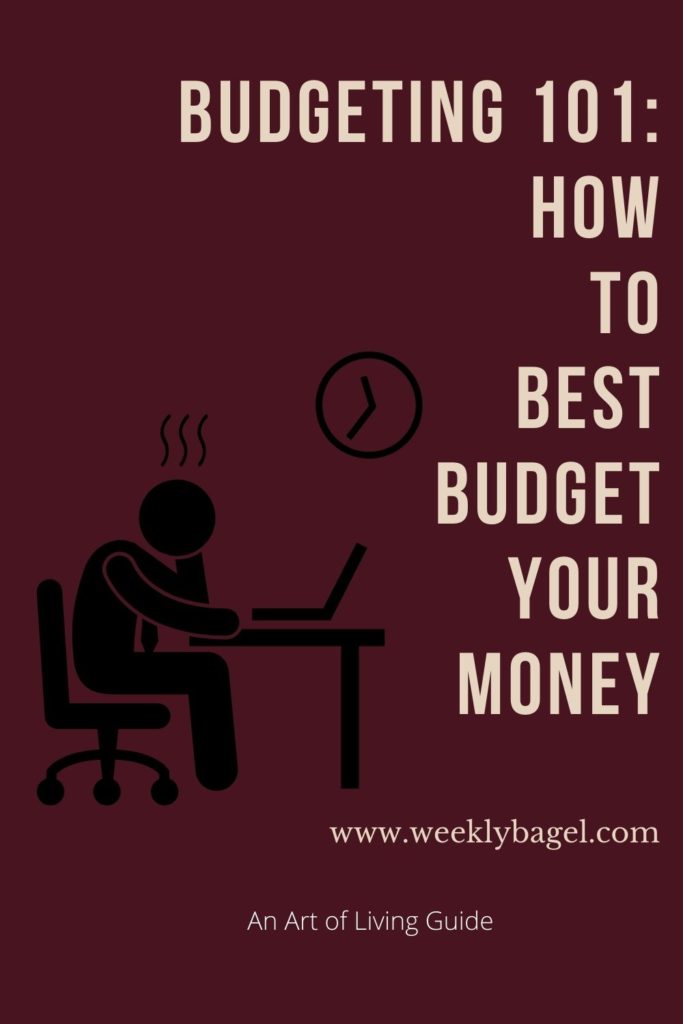
It is not a happy feeling living from paycheck to paycheck. This feeling is greatly amplified, when your monthly expenses always leave you without a single cent to save. This is not a problem caused by the government, the tax rate or your family. If you examine the problem closely, you will find that it is an issue caused by an inability to organize your monthly spending based on your estimated monthly income and expenses. There is no prior knowledge on how to best budget your money.
Hence, the lack of money in your purse despite a steady income stream.
A budget remedies this problem. This is because a budget gives you control over your money. It is a sort of money regulation plan. A budget takes accounts of your monthly expenses. Then, it allocates the money to them from a projected income within time period.
Furthermore, a budget is often preceded by a goal or some goals. The goals may include frugal living, debt reduction, increase in monthly savings or curiosity on what happens to your monthly income. It shows you the reason why you are still broke, despite a steady monthly income.
No worries. You are in the right place. Today, I will teach you how to best budget your money so that you will have enough money for things that matter to you. Now to the point at hand:
How To Make A Budget Plan
These are my five step by step guide to a personal budget.
1. Create A Scale Of Preference
A scale of preference is a list of your wants in the order of their importance in your life. This is very important in creating a budget, because it helps you see the things that are eating into your monthly income. Not only are you able to see these things, but also you could deal with them since they are not important in your daily living.
To create a scale of preference, make a list of your monthly expenses. Examples of these monthly expenses include your rent, utility bills, clothing, food, car gas, hangouts with friends, and other sort of expenses. Take your time, think it through and list them.
Here is a tip. Use your bank statement to get a list of your monthly expenses. It will show you what you need to add a list to your scale of preference. Once you have listed your monthly expenses, classify them into necessities and wants. Necessities are things you cannot live without, while you can survive without wants.
Hold on. Let me elaborate.
Food and shelter are necessities. However, eating out in restaurants with friends is not a necessity. Also, I will classify car gas as a necessity if you have a car. It is all about what is going to create you great inconvenience, when it is taken away. That is what I called a necessity.
Do you get it now?
Once you have classified your expenses, rearrange them from most important to the least important. You can use numbers or asterisks for this purpose. Assign ascending or descending numbers to the expenses; Or, you can assign a single asterisk or double asterisks to show importance. Whatever works for you. If this is successfully done, you have covered the first practical step on how to best budget your money.
2. Using After-Tax Income, Allocate Money To Expenses
You have finished creating a scale of preference to distinguish your wants from your needs, according to the order of their importance in your life. The next time to do now is to allocate money to necessary monthly expenses. This is done with an estimated after-tax income. Do not use income before tax. You may end up incurring a debt, due to a wrong estimated monthly income.
So, what do I mean by an estimated after-tax income?
It means the income that you bring home after it has been taxed. For example, you made $1500 before taxation is applied. If the federal income tax rate is 10% in a state that does not tax income, your estimated after-tax income is $1350. This is because you paid $150 in tax. Then, you brought back home $1350.
Your income, $1350, is going to be what you will be working on. Meaning- you create your budget from it. This include allocating money to your estimated monthly expenses.
Now, let us make a list of assumed monthly expenses and allocate money to them. Below is an example of your allocated money to your estimated monthly expenses based on the $1350 after-tax income.
- Rent = $689
- Food = $250
- Water = $40
- Light = $25
- Car Gas = $120
- Car Insurance = $120
- Miscellaneous = $50
- Total monthly expenses = $1294
- Amount remaining after expenses: $1350- $1294 = $56
As for the above example, allocation is based on a young Texan adult making $675 biweekly after tax. Since the State of Texas does not tax income, it is easier for this adult to create this budget and have $56 left every month. There is a lot of misconception that budget creation imposes limitations and restrictions on your Art of Living. Obviously, this is not true from the above.
In fact, the above is from a young friend of mine. A year ago, I created the budget for him. With his permission, I put it here.
When you create a scale of preference, it is easy to allocate money from your monthly income to your expenses. You can see that my friend has no health insurance or car note. That is because he is not making that much yet to afford a new car or health insurance, so they are not necessities since he is young, vibrant and healthy. He is comfortably driving a 2002 Toyota car paid in full.
Finally, his electrical bills is $25 monthly. This is because he adopted my electric bill principle. His budget currently saves him $672 annually. Such is the power of allocating money to estimated monthly expenses during budget creation. It shows you what you need, what you save and what you do not need.
3. Include 10% Of Your Income For Emergency
Let us face it. Life is unpredictable. An unplanned emergency can rip apart your budget. In all honesty, a contingency plan is a necessity during budget creation.
These emergencies include car maintenance, clinic visits, funeral, textbooks, a friend in need and so on. During the allocation of money to expenses, create the untouchable 10%. It sounds funny, but that is what it is. You take out 10% of your after-tax monthly income; then, set it aside for a time period. Usually, I recommend at least twelve months. A year is enough for it to grow into a tangible amount.
Let me explain.
If you are making $2000 monthly after tax, then put aside $200. We may think that is much, but it is not. Actually, 10% is my recommended minimum for such a monthly income. Emergencies do not happen every month. I always advice to start with 10%, because the remaining 90% of after-tax income is enough to take care of your monthly problems.
Unless you are living above your means, this should not be a problem. Am I right?
Now, I understand that there are other variables that could make it hard to include the untouchable 10% in your budget. You could be a single parent household. The tax rate of your state may offset this part of your budget. Or even, the amount you make monthly may not be enough.
Speaking of these variables, it is important to consider them before setting aside 10% when you budget your money monthly. If you can go up on 10% for emergency, include it on your budget. Or else, do not try to enforce what you cannot get away with. Try a lower percentage; 5% is not bad at all.
4. Monitor Your Allocated Expenses
To meet the goals behind your budget, it is important to monitor your expenses. From your scale of preference, you already know the expenses to keep or get rid of. Also, the allocation of money from your monthly income to your estimated monthly expenses show you where your money is going. Putting aside 10% makes cash available when an emergency occurs.
Seeing all these now, monitoring your expenses ensures that the integrity of your budget remains. Meaning- the objectives behind the budget are met.
How do you monitor the allocated expenses on your budget?
Well, there are some expenses apps on the apple and android stores. These help you stay on track. Some expenses apps let you record the receipts of transactions, while others let you create budget on them. Find the one that works with you; then, use it to monitor allocated expenses to make sure you are following your budget.
Also, you can do this by implementing limits on spending. Once you have allocated a certain amount to an expense, you cannot spend more than you have allocated. This is for fixed expenses, not variable ones. Even when the expenses vary monthly, steps can be taken to ensure that they are kept under control; that is within allocated limits.
For instance,
You are a heavy coffee drinker like me. Let us assume that you drink it more than twice a day. Each cup costs you $2.11. If you stuck with two cups a day, that is $4.22 daily. It means that you spend about $126.6 monthly. When your budget allocates $4.22 daily for coffee, make sure you do not go over two cups of coffee or get a coffee that cost more than $2.11. That is what I mean.
I hope you got it now?
Once you create the budget, stick to it. That is how you make it work. If not, it is going to offset everything. And, you will be back to being broke, in debt and confused about why you are penniless. Monitor your allocated expenses, and you will successfully budget your money.
5. Be Consistent In Following Your Plan
This last step is where most people fail. A lot of us create budget, but we fail to be consistent with it. Usually, this happens a lot on new year eve. A monthly budget and some annual money goals are created to help us through the new year. After a few months, these are neglected as with most new year resolutions.
So, how do we make sure it does not happen to us?
To avoid this issue, we use the resources available to us. These resources include budget planners, apps , annual calendar and white boards. I am a huge proponent of white boards. You know, the kind that Walmart carries. I recommend this, because you can write your budget on them. Then, pin them on the walls of your private residence.
Personally, I used a white board and a journal for my monthly expenses. This is because I am sorta a traditional West African and American budget freak. I am used to budgeting on my private journal or white boards. On the other hand, I realize this is not convenient for everyone. Due to this, I would recommend you use the money for white boards to buy a paid version of a budget app. Some of them can be set to notify you when there is a breach in consistency.
For example,
You can set some of the budgeting apps to notify at the end of the day to enter your daily expenses. And, they will beep loudly at the assigned time. So, there will be no excuse for not monitoring your expenses or following your budget plan. If you want to successfully budget your money, use the available resources to stay consistent.
Other Ways Of Creating A Budget
You can use budgeting apps to set up a monthly budget. Some of these budgeting services would want you to link your financial accounts, so your expenses will be tracked and categorized. This is to help show where you can save money.
One of such budgeting apps is Rocket Money. It can help you create budget and set financial goals. In addition, you will be notified of milestones. In short, it will help you track and manage your monthly expenses. Check it out.
That is the end of my five steps on how to best budget your money.
In conclusion of today’s post, I want you to set aside time today. Go buy a journal, a white board or a budget app. Then, use the steps here to budget your money. If you stick with it for a whole year, you will be very glad that you did. Trust me, I am a budget fanatic. And, I know what I am talking about!




 5 Practical Ways To Get Out of Debt
5 Practical Ways To Get Out of Debt